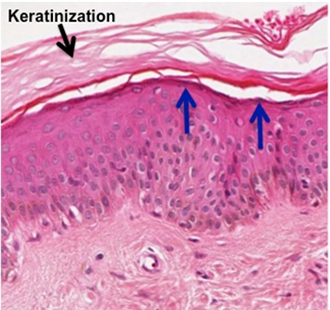| Stratified squamous (keratinized)
This type of epithelium is many cell
layers thick, its surface cells are squamous in shape, and its most
superficial layers are keratinized.
- This epithelium is found in the
skin where it’s called the epidermis and serves as a strong,
covering and protective layer that helps prevent dehydration of
the body.
- Some areas in the oral cavity
and on the superior surface of the tongue are also lined by
stratified squamous, keratinized epithelia.
- Take a look at this example of
epidermis,
 as well
as an image of epidermis to the right. as well
as an image of epidermis to the right.
- Note that the superficial layers
are very thin and lack nuclei. These layers are composed of
bundles of keratin intermediate filaments, which form as the
epithelial cells differentiate and die. Also note the squamous
shape of the last layer of nucleated cells (blue arrows) located
just beneath the keratinized layer.
- The most superficial keratinized
layers are only loosely attached and are steadily lost
(desquamated) and replaced.
Stratified
cuboidal and transitional epithelium. |